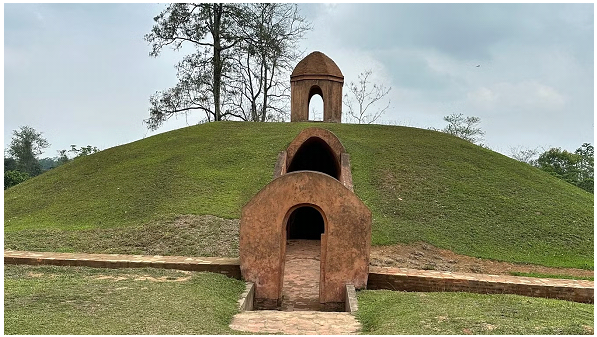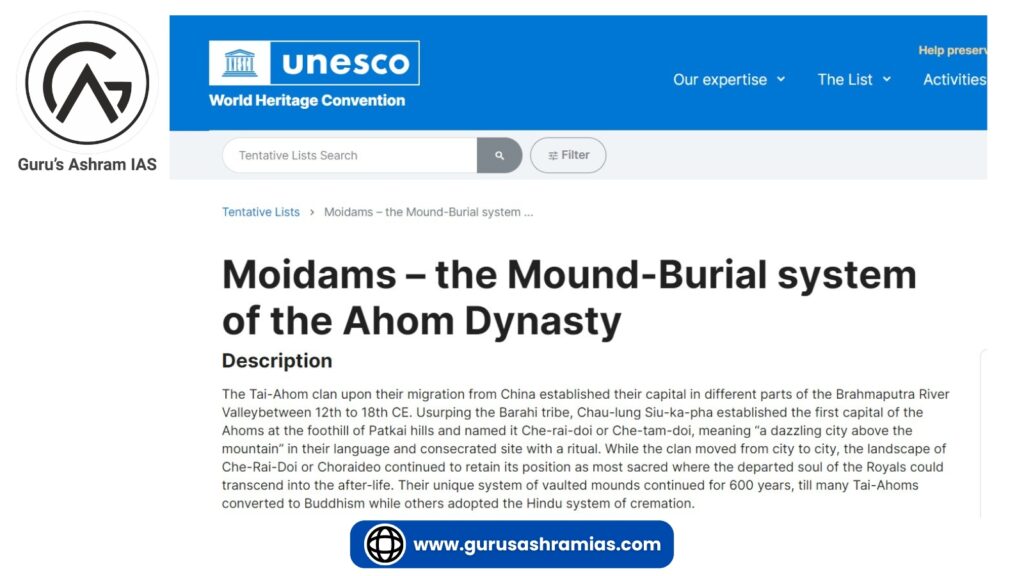‘Moidams’ of Ahom dynasty
- Recently, during the 46th session of the World Heritage Committee, a proposal has been made to include the ‘Moidams’ of the Ahom dynasty in the World Heritage Site list.
- India is hosting this session for the first time in July 2024 in New Delhi.
- The UNESCO World Heritage List currently includes 1,199 properties from 168 countries.

Moidams:
- These are the tombs (13th-19th century) built for the royal families of the Ahom kingdom in Charaideo district of Assam.
- They were constructed mainly of mud, bricks and stone. The outer structure usually consisted of a mound of earth, often surrounded by a brick or stone wall.
- It used to bury the mortal remains of members of the royal families of the Ahom kingdom.
- After the 18th century, the Ahom rulers adopted the Hindu cremation system and started burying the cremated bones and ashes at Charaideo.
- These burial practices of the Ahom dynasty are comparable to the ancient royal tombs of China and the pyramids of the Egyptian pharaohs.
Ahom Kingdom:
- The Ahom kingdom was founded in the year 1228 in the Brahmaputra valley of Assam and maintained its sovereignty for 600 years.
- It was founded by the 13th century ruler Chaolung Sukapha in the year 1253.
- Charaideo was their early capital, located 400 km east of Guwahati.
- The Ahom dynasty ruled for nearly 600 years, until the British annexed Assam through the Treaty of Yandaboo in 1826.
Political System:
- The Ahoms established a new empire by suppressing the old political system of bhuiyans (landlords).
- The state was dependent on forced labour. Those who did this kind of labor for the state were called Paik.
Society:
- The Ahom society was divided into clans or games. Often several villages were controlled under one game.
- The people of the Ahom kingdom worshipped their own tribal deities, yet they accepted Hinduism and the Assamese language.
- The Ahom kings, however, did not completely abandon their traditional beliefs after adopting Hinduism.
Military Strategy:
- The entire contingent of the Ahom army consisted of infantry, navy, artillery, elephants, cavalry, and spies.
- The main armament consisted of bows and arrows, swords, spears, guns, gunpowder firearms and cannons.
- The Ahom soldiers were skilled in guerrilla warfare. He also learnt the technique of building boat bridges in the Brahmaputra.
- The Ahom navy led by Lachit Borphukan defeated the Mughal army commanded by Ram Singh I during the reign of Aurangzeb at the Battle of Saraighat in 1671.
- Lachit Borphukan Gold Medal is awarded to the best cadet of the National Defence Academy.
- The medal was introduced in 1999 to inspire defence personnel to emulate the valour and sacrifice of Borphukan.
UNESCO World Heritage Sites:
- A World Heritage Site is a place that is listed by UNESCO because of its unique cultural or physical significance.
- The list of World Heritage Sites is prepared by the ‘World Heritage Programme’, administered by the ‘World Heritage Committee’ of UNESCO.
- This list is related to an international treaty called ‘Convention relating to the Protection of the World Cultural and Natural Heritage’ adopted by UNESCO in the year 1972.
- India has 42 World Heritage Sites (34 cultural, 7 natural and 1 mixed site). The latest destinations include Shantiniketan (2023) and the Holy Temple of Hoysala (2023).




